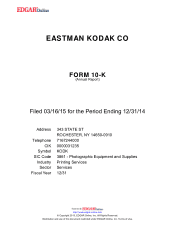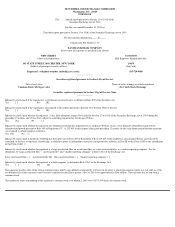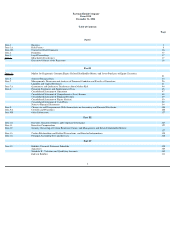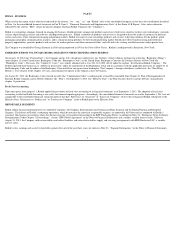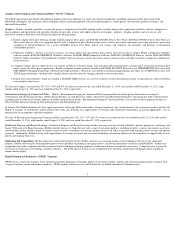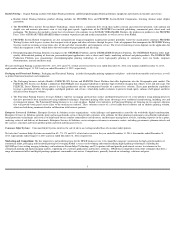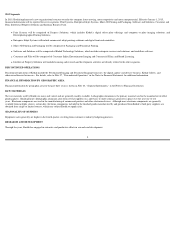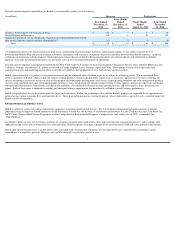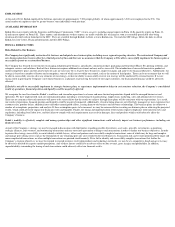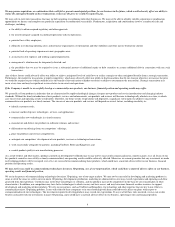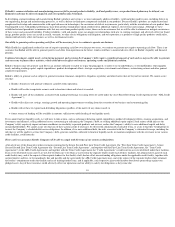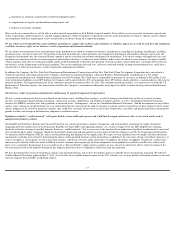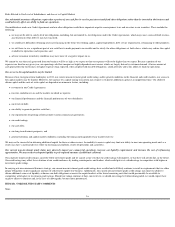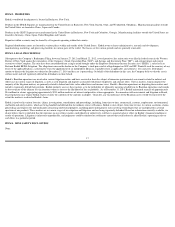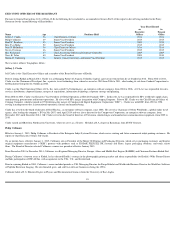Kodak 2014 Annual Report Download - page 9
Download and view the complete annual report
Please find page 9 of the 2014 Kodak annual report below. You can navigate through the pages in the report by either clicking on the pages listed below, or by using the keyword search tool below to find specific information within the annual report.
EMPLOYMENT
At the end of 2014, Kodak employed the full time equivalent of approximately 7,300 people globally, of whom approximately 3,200 were employed in the U.S. The
actual number of employees may be greater because some individuals work part time.
AVAILABLE INFORMATION
Kodak files many reports with the Securities and Exchange Commission (“SEC”) (www.sec.gov), including annual reports on Form 10-K, quarterly reports on Form 10-
Q and current reports on Form 8-K. These reports, and amendments to these reports, are made available free of charge as soon as reasonably practicable after being
electronically filed with or furnished to the SEC. They are available through Kodak's website at www.Kodak.com. To reach the SEC filings, follow the links to About
Kodak, Investor Center, Financial Information and then SEC Filings.
ITEM 1A. RISK FACTORS
Risks Related to Our Business
The Company has significantly restructured its business and adopted a new business plan, including a new segment reporting structure. The restructured Company and
new business plan have been in effect for a limited period of time and there are no assurances that the Company will be able to successfully implement its business plan or
successfully operate as a restructured business.
The Company has focused its investments on imaging and printing for business, specifically, commercial inkjet, packaging and functional (Micro 3D) printing solutions, and
enterprise services and solutions. Each of these businesses requires additional investment and may not be successful. The introduction of successful innovative products at
market competitive prices and the achievement of scale are necessary for us to grow these businesses, improve margins and achieve our financial objectives. Additionally, our
strategy is based on a number of factors and assumptions, some of which are not within our control, such as the actions of third parties. There can be no assurance that we will
be able to successfully execute all or any elements of our strategy, or that our ability to successfully execute our strategy will be unaffected by external factors. If we are
unsuccessful in growing the Company’s investment businesses as planned, or perceiving the needs of our target customers, our financial performance could be adversely
affected.
If Kodak is not able to successfully implement its strategic business plans, or experiences implementation delays in cost structure reduction, the Company
’
s consolidated
results of operations, financial position and liquidity could be negatively affected.
We recognize the need to rationalize Kodak’s workforce and streamline operations to a leaner and more focused organization aligned with the emerged businesses and
operations. We have implemented such cost rationalization plans including a restructuring of manufacturing, supply chain, marketing, sales and administrative resources.
There are no assurances that such measures will prove to be successful or that the results we achieve through these plans will be consistent with our expectations. As a result,
our results of operations, financial position and liquidity could be negatively impacted. Additionally, if restructuring plans are not effectively managed, we may experience lost
customer sales, product delays, additional costs and other unanticipated effects, causing harm to our business and customer relationships. The business plans are subject to a
number of assumptions, projections, and analysis. If these assumptions prove to be incorrect, we may be unsuccessful in executing our business plan or achieving the projected
results, which could adversely impact our financial results and liquidity. Finally, the timing and implementation of these plans require compliance with numerous laws and
regulations, including local labor laws, and the failure to comply with such requirements may result in damages, fines and penalties which could adversely affect the
Company’s business.
Kodak
’
s inability to effectively complete and manage partnerships and other significant transactions could adversely impact our business performance, including our
financial results.
As part of the Company’s strategy, we may be engaged in discussions with third parties regarding possible divestitures, asset sales, spin-offs, investments, acquisitions,
strategic alliances, joint ventures, and outsourcing transactions and may enter into agreements relating to such transactions in order to further our business objectives. In order
to pursue this strategy successfully, we must identify suitable buyers, sellers and partners and successfully complete transactions, some of which may be large and complex,
and manage post-closing issues such as the elimination of any remaining post-sale costs related to divested businesses. Transaction risk can be more pronounced for larger and
more complicated transactions, or when multiple transactions are pursued simultaneously. If we fail to identify and successfully complete transactions that further the
Company’s strategic objectives, we may be required to expend resources to develop products and technology internally, we may be at a competitive disadvantage or we may
be adversely affected by negative market perceptions. Any of these factors could have an adverse effect on our revenue, gross margins and profitability. In addition,
unpredictability surrounding the timing of such transactions could adversely affect our financial results.
8

